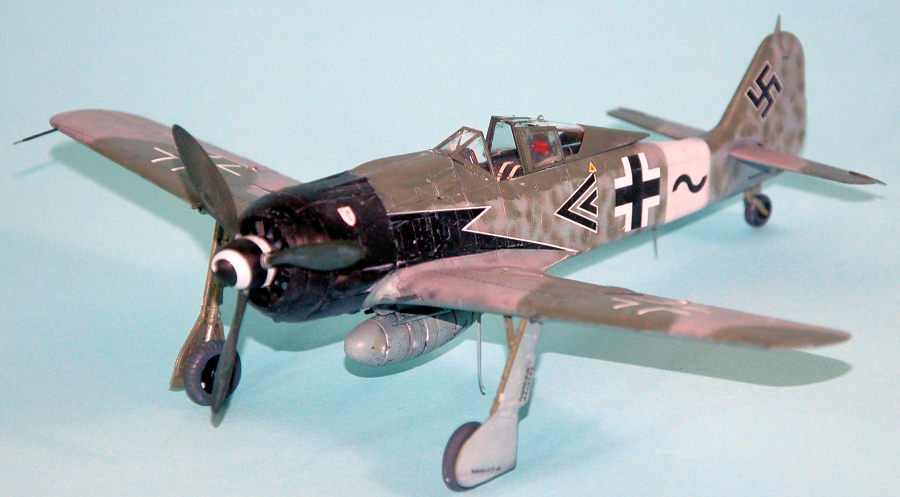
| KIT #: | 11119 |
| PRICE: | $16.98 |
| DECALS: | Seven options |
| REVIEWER: | Tom Cleaver |
| NOTES: | Kit contains Fw-190A-8/R2 and Bf-109G-14 |

| HISTORY |
While the Luftwaffe was fairly successful in attacking Eighth Air Force bomber formations in the “Twelve O-Clock High” head on tactic, the closing rate was so high that pilots did not have an adequate time to take aim on a specific target before they were through the formation.
In April 1943, Major Hans-Günther von Kornatzki took command of the experimental Sturmstaffel 1 to develop suitable tactics and equipment to allow intercepting fighters to close with the bombers and thus obtain greater accuracy. This was extremely dangerous, due to the heavy defensive armament of the B-17 and B-24. At first, the unit operated unmodified Fw-190A-6 fighters. The aircraft were progressively modified with armor around the cockpit and ahead of the cockpit, and armored glass “blinkers” to either side of the canopy. In January 1944, the unit equipped with Fw-190A-7s that were modified with 30mm MK 108 cannon in the outer wing.
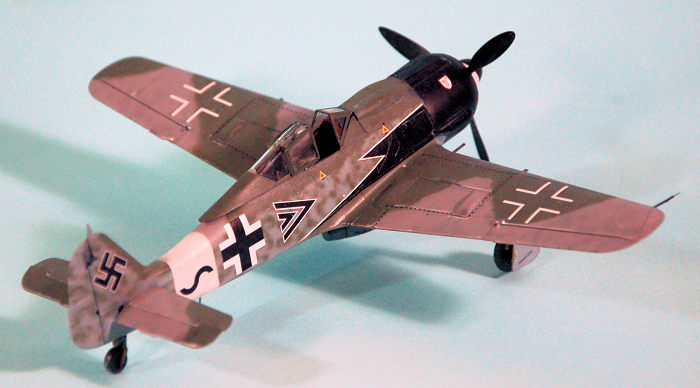 The Fw-190A-8
entered production in February 1944, powered either by the standard BMW 801 D-2.
Specially modified in the “R2" development, the BMW 801Q/TU, which was a
standard 801D with improved, thicker armor on the front annular cowling, which
still incorporated the cooler, upgraded from 6 mm to 10 mm. Changes also
included the C3-injection Erhöhte Notleistung emergency boost system, raising
power to 1,953 hp for a short time. The
The Fw-190A-8
entered production in February 1944, powered either by the standard BMW 801 D-2.
Specially modified in the “R2" development, the BMW 801Q/TU, which was a
standard 801D with improved, thicker armor on the front annular cowling, which
still incorporated the cooler, upgraded from 6 mm to 10 mm. Changes also
included the C3-injection Erhöhte Notleistung emergency boost system, raising
power to 1,953 hp for a short time. The
Fw-190 A-8/R2 also replaced the outer wing 20 mm cannon with a 30 mm MK 108 cannon. In this form, the aircraft was known as the “Sturmbock.” It was considerably heavier than the standard A08, and Sturmbock units needed escort from standard Fw-190s or Bf-109s since they were at a disadvantage in fighter vs fighter combat.
Wilhelm Moritz:
Major Wilhelm Moritz joined the German army in 1933. In 1935, he transferred to the new Luftwaffe. Following graduation from flight training, he served intially with II/ZG 1, flying the Bf-110C in the Polish and French campaigns.
In the summer of 1940, serving with the unit in Norway and France during the Battle of Britain. On 9 1940, he was appointed Staffelkapitän of 6./JG 77. In January 1941, he became Staffelkapitän of EinsatzStaffel/JFS 4 and commanded the unit until March 1942. The unit was later integrated into 11./JG 51 and between April 4 - September10, 1942, he was Staffelkapitän of 11./JG 1at Mönchen-Gladbach. During this period he was promoted to Hauptmann. He claimed no victories while serving with this unit operating in the German Bight and Holland.
Moritz was transferred to II./JG 51 on the Eastern Front September 10, 1942.
That November 1942, he was named Staffelkapitän of 12./JG 51. Between then and
the end of September 1943, he claimed 25 victories. On October 9, 1943, Moritz
was appointed Staffelkapitän of 6./JG 3 based in Germany. The unit was assigned
to the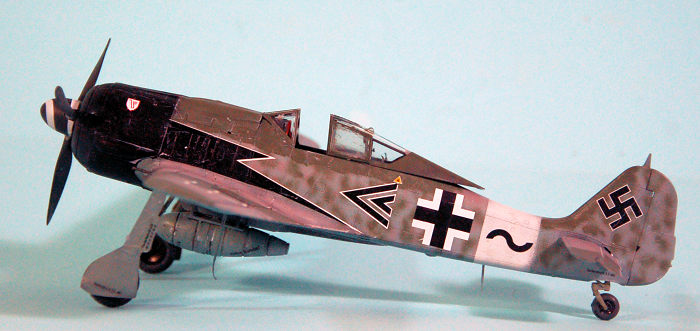 Reichsverteidigung.
Reichsverteidigung.
Moritz was appointed Gruppenkommandeur of IV (Sturm)/JG 3 on April 18, 1944. The Gruppe flew Fw-190A-8/Rs fighters in anti-bomber operations. On May 8, he claimed two 8th Air Force B-24 four-engined bombers Herausschüsse as his 36th and 37th victories. On May 13, he claimed two B-17s (38-39). Moritz was awarded the Ritterkreuz for 41 victories on July 18, 1944. On October 1, he was promoted to the rank of Major. On November 2, he claimed a B-17, his 44th and, probably, last victory.
On 5 December, Moritz was relieved of command due to a complete nervous breakdown. Following recuperation he was appointed Gruppenkommandeur of IV./EJG 1 on December 14. On April 18, 1945, He was appointed Gruppenkommandeur of II/JG 4, serving with the unit until the end of the war.
In over 500 combat missions Wilhelm Moritz was credited with 44 confirmed victories. His 25 Western Front victories included 12 four-engined bombers. However, some sources quote his totalas high as 54, including 25 four-engined bombers (including Herausschüsse).
Moritz’s most successfull mission was on July 7, 1944. A force of 1,129 B-17 Flying Fortresses and B-24 Liberators of the Eighth Air Force were sent to bomb aircraft factories in Leipzig and the synthetic oil plants at Boehlen, Leuna-Merseburg and Lützkendorf. Hauptmann Moritz led IV.(Sturm)/JG 3 "Udet," escorted by two Gruppen of Bf 109s from JG 300 led by Geschwader Kommodore Major Walther Dahl. Dahl and Moritz led the attack to point-blank range against the B-24s of the 492nd Bombardment Group - which was temporarily without fighter cover - hitting them from the rear. The Fw-190s and Bf-109s swarmed the bombers and within a minute the entire lower squadron of 12 B-24s had been shot down. The Germans claimed 28 2nd Air Division B-24s shot down and were credited with 21, the majority to Moritz’s Gruppe. This action led to Moritz’s award of the Knight’s Cross.
| THE KIT |
 Eduard
released the Fw-190A-8/R2 sub-type in their earlier line of Fw-190s. The kit has
now been released in a special “limited edition” Dual Combo kit with the Fw-190A-8/R2
and Bf-109G-14. This is a specific release for this sub-type only, done from the
new “easy” Eduard Fw-190 kit that is the best Fw-190 series now available. The
fuselage has the external armor around the cockpit molded into the surface
detail and the lower wing specifically has the MK 108 shell ejection chutes.
This is superior to the Tamiya Fw-190A-8/R2, which had precut “Tamiya tape”
armor for the fuselage and required the modeler to cut out the ejection chutes.
Eduard
released the Fw-190A-8/R2 sub-type in their earlier line of Fw-190s. The kit has
now been released in a special “limited edition” Dual Combo kit with the Fw-190A-8/R2
and Bf-109G-14. This is a specific release for this sub-type only, done from the
new “easy” Eduard Fw-190 kit that is the best Fw-190 series now available. The
fuselage has the external armor around the cockpit molded into the surface
detail and the lower wing specifically has the MK 108 shell ejection chutes.
This is superior to the Tamiya Fw-190A-8/R2, which had precut “Tamiya tape”
armor for the fuselage and required the modeler to cut out the ejection chutes.
Decals are included for seven different Sturmbocks. The IV/JG 3 aircraft in this release is the airplane flown by Willi Maximowitz. Since I still had the decal sheet from the earlier Eduard release, which has Moritz’s airplane, I decided to use the personal markings from that sheet on this model.
| CONSTRUCTION |
Construction essentially follows that of the other new Eduard Fw-190 kits. Read and follow the instructions, take care in cleaning off all sprue nubs when you cut the parts off the sprues, take your time in careful assembly, and in a matter of a few hours you will have a really nice model, lacking (mostly) any filler on any join (any filler used is due to “modeler-induced mistakes”), ready for painting.
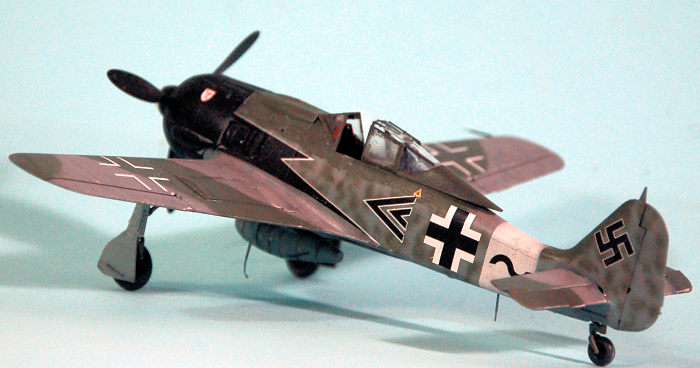 One
particular thing to do is to lightly scrape around the inner gun bay door that
sticks out from the upper wing part, and to lightly scrape the area of the
fuselage part where that will fit. If you don’t do that, you will be forced to
engage in some industrial-strength pushing and shoving to get the parts
together. If you do this, the parts will “click together.”
One
particular thing to do is to lightly scrape around the inner gun bay door that
sticks out from the upper wing part, and to lightly scrape the area of the
fuselage part where that will fit. If you don’t do that, you will be forced to
engage in some industrial-strength pushing and shoving to get the parts
together. If you do this, the parts will “click together.”
I find that it’s good to pre-paint as much detail as possible before further assembly. However, it is a good idea to scrape off any paint on surfaces to be glued together, because parts fit is so precise that the thickness of a coat of airbrushed paint can put things off.
| COLORS & MARKINGS |
I chose to do Wilhelm Moritz’s airplane, using the personal markings from the decal sheet for the old Eduard Fw-190 kit, supplementing those with the other decals from the new kit since they are printed by Cartograf.
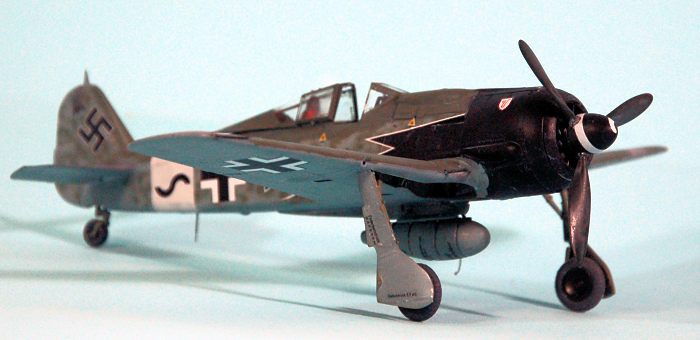 I first
painted the engine cowling black and pre-shaded the rest of the model along
panel lines. I then painted the white Reichverteidigung band on the rear
fuselage. I masked off the cowling and the white band, and painted the model
freehand with my Tamiya mixtures for RLM 74,75, and 76. The fuselage of this
airplane has heavy mottle in RLM 74 and 75. I then gave the model an overall
coat of clear gloss.
I first
painted the engine cowling black and pre-shaded the rest of the model along
panel lines. I then painted the white Reichverteidigung band on the rear
fuselage. I masked off the cowling and the white band, and painted the model
freehand with my Tamiya mixtures for RLM 74,75, and 76. The fuselage of this
airplane has heavy mottle in RLM 74 and 75. I then gave the model an overall
coat of clear gloss.
The decals went on without problem, though the old Eduard decals used for the personal markings had to be encouraged to lie down and set. When all was finished and the decals had set overnight, I gave the model two coats of clear flat.
| FINAL CONSTRUCTION |
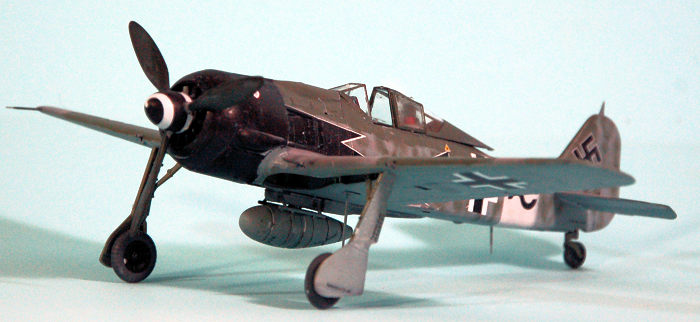 I really like
that Eduard has designed the landing gear so that one has to really work to not
get it aligned properly. Putting things in the way they fit pretty much
guarantees that the landing gear will be properly aligned. This is really
useful, since improper alignment of the gear is the single most common mistake
most of us manage to do at least a few times in our Fw-190 modeling.
I really like
that Eduard has designed the landing gear so that one has to really work to not
get it aligned properly. Putting things in the way they fit pretty much
guarantees that the landing gear will be properly aligned. This is really
useful, since improper alignment of the gear is the single most common mistake
most of us manage to do at least a few times in our Fw-190 modeling.
Once the gear was attached, I attached the drop tank and prop, and then attached the canopy in the open position after attaching the “blinkers.” I then applied exhaust staining.
| CONCLUSIONS |
I love the Eduard 190s. They are the best kits of this famous airplane available in 1/48 and are only challenged by Eduard’s 1/72 190s. They are easy to assemble and are as close to “fool proof” as can be (but never doubt the ability of fools to take such a statement as a challenge). No one else has done a specific kit for the Fw-190A-8/R2 sub type before, and this is really nice. Highly recommended for Wurger Fans.
17 January 2019
Review kit courtesy of Eduard.
If you would like your product reviewed fairly and fairly quickly, please contact the editor or see other details in the Note to Contributors.
Back to the Main Page Back to the Review Index Page Back to the Previews Index Page